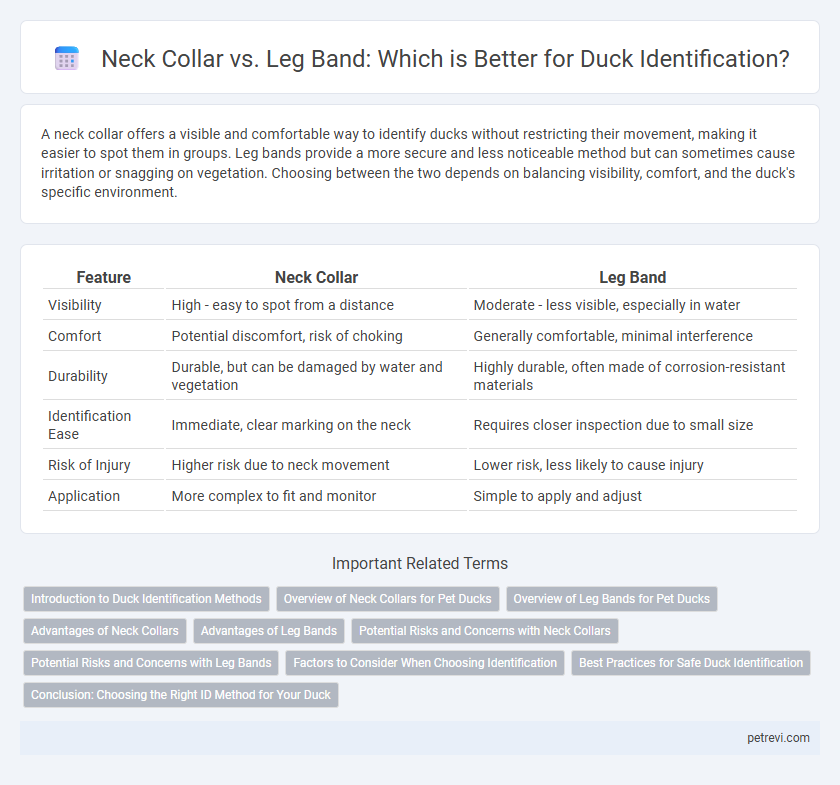A neck collar offers a visible and comfortable way to identify ducks without restricting their movement, making it easier to spot them in groups. Leg bands provide a more secure and less noticeable method but can sometimes cause irritation or snagging on vegetation. Choosing between the two depends on balancing visibility, comfort, and the duck's specific environment.
Table of Comparison
| Feature | Neck Collar | Leg Band |
|---|---|---|
| Visibility | High - easy to spot from a distance | Moderate - less visible, especially in water |
| Comfort | Potential discomfort, risk of choking | Generally comfortable, minimal interference |
| Durability | Durable, but can be damaged by water and vegetation | Highly durable, often made of corrosion-resistant materials |
| Identification Ease | Immediate, clear marking on the neck | Requires closer inspection due to small size |
| Risk of Injury | Higher risk due to neck movement | Lower risk, less likely to cause injury |
| Application | More complex to fit and monitor | Simple to apply and adjust |
Introduction to Duck Identification Methods
Neck collars and leg bands are common methods used for duck identification, each offering unique advantages in tracking and studying duck populations. Neck collars provide high visibility and easy recognition from a distance, making them suitable for observing behavior in the wild. Leg bands are more durable and less intrusive, ideal for long-term monitoring and data collection on individual ducks.
Overview of Neck Collars for Pet Ducks
Neck collars for pet ducks provide a visible and durable method of identification, often crafted from lightweight, waterproof materials to ensure comfort and prevent irritation. These collars come in various sizes and colors, allowing owners to easily distinguish individual ducks within a flock. Unlike leg bands, neck collars minimize the risk of injury associated with leg movement, making them a practical option for monitoring pet ducks in diverse environments.
Overview of Leg Bands for Pet Ducks
Leg bands for pet ducks provide a reliable and minimally invasive method for individual identification, typically made from durable materials like aluminum or plastic to withstand water exposure and outdoor conditions. These bands come in various sizes and colors, allowing easy visual differentiation between ducks while ensuring comfort and mobility. Unlike neck collars, leg bands reduce the risk of entanglement and injury, making them a safer option for long-term identification in pet ducks.
Advantages of Neck Collars
Neck collars provide highly visible identification for ducks, making it easier to distinguish individuals from a distance in both wild and domestic settings. These collars are less likely to cause discomfort or restrict movement compared to leg bands, promoting natural behavior and reducing stress. Their durability ensures long-lasting use, ideal for tracking migration patterns or managing breeding populations efficiently.
Advantages of Leg Bands
Leg bands provide a reliable and visible method for duck identification, allowing for easy monitoring without restricting movement or causing discomfort. They are durable, water-resistant, and less likely to interfere with natural behaviors compared to neck collars. Leg bands also minimize the risk of injury or entanglement, making them a safer choice for long-term tracking.
Potential Risks and Concerns with Neck Collars
Neck collars for duck identification pose potential risks including strangulation, feather damage, and increased vulnerability to predators due to restricted movement. Ducks may also experience discomfort or injury if the collar is too tight or becomes entangled in vegetation. In contrast, leg bands minimize these risks by allowing freer movement, though they come with their own challenges like leg irritation or loss.
Potential Risks and Concerns with Leg Bands
Leg bands for duck identification pose risks such as leg injury, infection, and impaired mobility, which can lead to difficulty in foraging and escaping predators. The bands may cause irritation or cuts if not properly sized or fitted, potentially resulting in long-term damage or loss of the limb. Monitoring is essential to prevent complications, as stress and discomfort from leg bands can impact overall duck health and behavior.
Factors to Consider When Choosing Identification
When choosing between a neck collar and a leg band for duck identification, consider durability, comfort, and visibility. Neck collars offer higher visibility from a distance but can cause discomfort or injury if not properly fitted, while leg bands are less intrusive but may be harder to spot and more prone to loss or damage. Material quality, size appropriateness, and the specific environment where the ducks reside significantly influence the effectiveness of either identification method.
Best Practices for Safe Duck Identification
For safe duck identification, neck collars provide visible, non-intrusive marking that minimizes leg injuries common with leg bands. Using lightweight, adjustable neck collars made from soft, durable materials ensures comfort and reduces stress for ducks. Leg bands require precise sizing and regular monitoring to prevent constriction and leg damage, making neck collars the preferred method in most practical wildlife management scenarios.
Conclusion: Choosing the Right ID Method for Your Duck
When selecting the ideal identification method for ducks, prioritize leg bands for long-term durability and ease of observation in both aquatic and terrestrial environments. Neck collars are more visible at a distance but may cause discomfort or snagging in dense vegetation, making them less suitable for active or wild ducks. Evaluating your duck's environment, behavior, and monitoring needs ensures the most effective and humane identification choice.
Neck Collar vs Leg Band for Duck Identification Infographic

 petrevi.com
petrevi.com